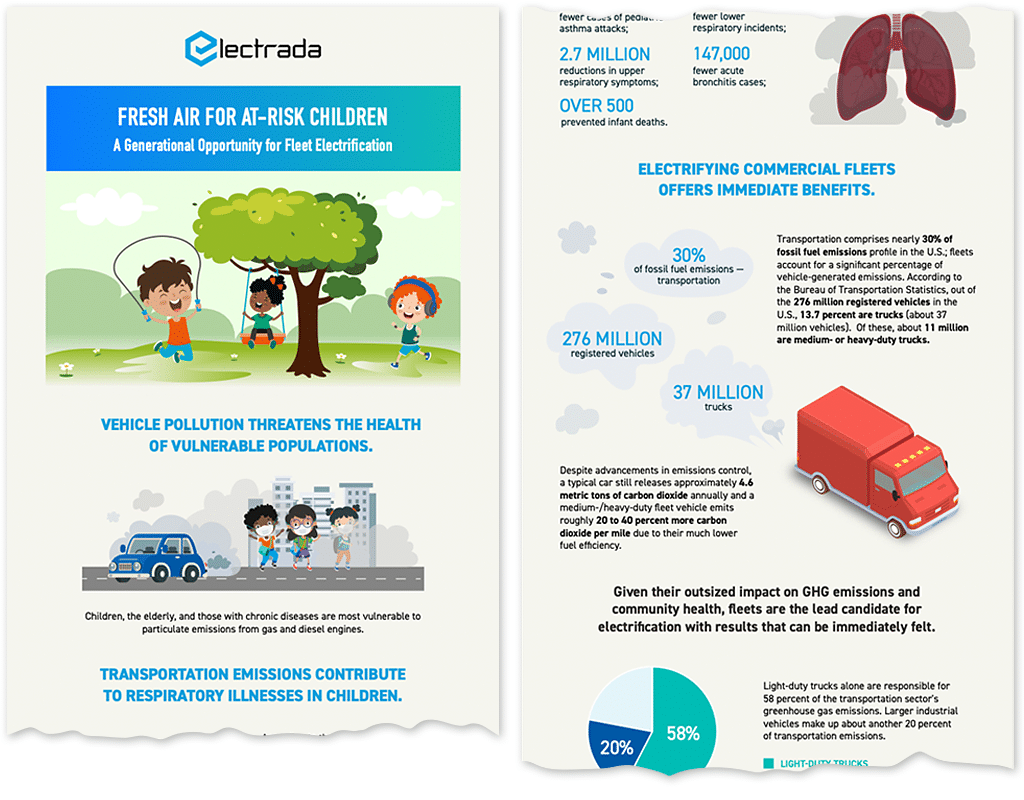The knowledge that there is an ozone layer blanketing our planet has provided its inhabitants with a subconscious sense of security, but that blanket of protection is being depleted by greenhouse gas emissions. More obvious today are the lurking health dangers beneath. While advances in combustion engine and liquid fuel technology are slow, incremental, and driven largely by legislation or litigation, the particulate emissions from gas and diesel engines continue to pose a significant cumulative threat, particularly to the most vulnerable: children, the elderly, and those with chronic diseases.
These individuals often have minimal control over their environment, yet bear the brunt of transportation choices companies and governments make. Ports, school bus depots, distribution centers, transit terminals, and manufacturing facilities are home to millions of fleet vehicles and are often close neighbors to areas of lowest economic mobility. Concentrated poverty shouldn’t mean concentrated pollution as well.
Is a Healthier Future Within Reach?
A pivotal February 2024 report by the American Lung Association (ALA), titled “Boosting Health for Children: Benefits of Zero-Emission Transportation and Electricity,” answers with a resounding yes. It outlines the transformative effects a nationwide shift to zero-emission transportation by 2040 and electric power generation by 2035 could have on children’s health.
Alarmingly, the report states that 120 million Americans reside in areas failing ALA’s air quality standards due to excessive ozone or particulate pollution. This includes 27 million children under age 18 — over a third of all children in the U.S. — living in communities adversely affected by emissions from vehicles, power plants, and refineries. Children are particularly vulnerable to air pollution due to their developing bodies and the fact that they breathe more often and inhale more air in relation to body weight compared to adults.
Transportation comprises nearly 30 percent of the fossil fuel emissions profile in the U.S., with passenger cars, trucks and other vehicles accounting for about half of that amount. Moreover, of vehicle-generated fossil fuel emissions, fleets are responsible for a significant percentage. According to the Bureau of Transportation Statistics, out of the 276 million registered vehicles in the U.S., 13.7 percent are trucks (about 37 million vehicles). Of these, about 11 million are medium- or heavy-duty trucks. However, the ALA forecasts that by 2050, transitioning to zero-emission vehicles and clean energy could result in significant health benefits for children, including:
- 2.8 million fewer cases of pediatric asthma attacks,
- 2.7 million reductions in upper respiratory symptoms,
- 1.9 million fewer lower respiratory incidents,
- 147,000 fewer acute bronchitis cases, and
- Over 500 prevented infant deaths.
These figures represent more than mere statistics. They signify fewer chronic respiratory conditions, uninterrupted education, financial relief for families, and reduced pressure on an already strained healthcare system. Moreover, cleaner air benefits maternal health and the prenatal development of a child’s lungs.
The Role of Fleets in Clearing the Air
So, what’s the most effective route to cleaner air?
Vehicles powered by gas and diesel emit harmful pollutants like nitrous oxides, sulfur dioxides (contributors to acid rain), methane, and carbon monoxide, along with the fine particulates that actually create the greatest harm to our lungs. Despite advancements in emissions control, a typical car still releases approximately 4.6 metric tons of carbon dioxide annually and a medium-/heavy-duty fleet vehicle emits roughly 20 to 40 percent more carbon dioxide per mile due to their much lower fuel efficiency.
Transitioning to electric vehicles (EVs) broadly is an essential step for our health and that of the planet. Yet, consumer adoption is lagging behind expectations due to high costs, charging infrastructure concerns, range anxiety, overpoliticization, and other factors.
A more immediate solution lies in electrifying vehicle fleets, particularly the numerous last-mile delivery vehicles, where there is immediate ROI for fleet owners and current EVs provide the range and reliability required to convert immediately. Such a shift could significantly reduce harmful emissions and greenhouse gases. We do know that light-duty trucks alone are responsible for 58 percent of the transportation sector’s greenhouse gas emissions, while larger industrial vehicles make up about another 20 percent of transportation emissions. Furthermore, an Australian study highlighted that electrifying just 10 urban delivery trucks has the same emission reduction impact as 56 households switching to EVs.
Fleet operators have distinct advantages, including business-specific incentives, bulk purchasing power, and access to Charging-as-a-Service (experienced third-party solutions to EV fleet charging infrastructure), which alleviate some of the common barriers faced by individual consumers. Even more impactful, for fleets that contract with renewable power generation as electric supply to charge, there is a compelling, fully zero-emission energy pathway, from generation of the electricity to its use to power a vehicle.
The detrimental health impacts of fossil fuel transportation, especially on vulnerable groups, are undeniable. Diesel school buses idling next to playgrounds, transit buses launching plumes of black exhaust around neighborhoods, and delivery trucks trailing exhaust should be images in our “national rear-view mirror”. By prioritizing fleet electrification for use cases and segments of greatest possible impact to at-risk communities, we not only safeguard our children’s health but, also, take a pragmatic step towards a sustainable, emission-free transportation future: an embedded ROI (human and economic) for all stakeholders.
Explore More with Our Infographic

Sources:
- https://8billiontrees.com/carbon-offsets-credits/carbon-ecological-footprint-calculators/truck-co2-emissions-per-km-calculator/#:~:text=How%20Much%20CO2%20Does%20a,26%25%20of%20the%20emissions%20data
- https://afleet.es.anl.gov/hdv-emissions-calculator/
- https://www.netradyne.com/blog/trucking-statistics-and-facts-for-fleet-managers-2022#:~:text=According%20to%20the%20American%20Trucking,the%20government%20and%20for%20farms
- https://www.bts.gov/content/us-automobile-and-truck-fleets-use-thousands
- https://ourworldindata.org/co2-emissions-from-transport#:~:text=Road%20travel%20accounts%20for%20three,comes%20from%20trucks%20carrying%20freight
- https://www.bts.gov/content/estimated-national-average-vehicle-emissions-rates-vehicle-vehicle-type-using-gasoline-and
- https://www.npr.org/2024/03/29/1241410274/emissions-heavy-duty-trucks-rule-epa
- https://www.bts.gov/browse-statistical-products-and-data/national-transportation-statistics/number-us-truck
- https://www.epa.gov/transportation-air-pollution-and-climate-change/smog-soot-and-other-air-pollution-transportation


